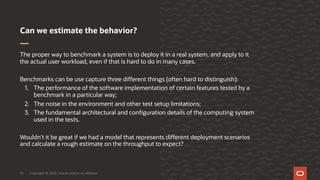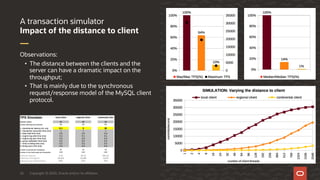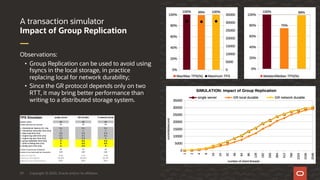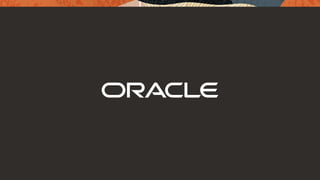MySQL Replication Performance in the Cloud
- 1. Performance Architect Oracle/MySQL/Replication Jan 31, 2020 Vítor Oliveira pre-FOSDEM 2020 MySQL Days MySQL Replication Performance in the Cloud
- 2. The following is intended to outline our general product direction. It is intended for information purposes only, and may not be incorporated into any contract. It is not a commitment to deliver any material, code, or functionality, and should not be relied upon in making purchasing decisions. The development, release, timing, and pricing of any features or functionality described for Oracle’s products may change and remains at the sole discretion of Oracle Corporation. Safe harbor statement Copyright © 2020, Oracle and/or its affiliates2
- 3. Copyright © 2020, Oracle and/or its affiliates3 5 4 3 2 1 Conclusion A transaction simulator Benchmarking replication Can we estimate the behavior? Introduction Agenda
- 4. Copyright © 2020, Oracle and/or its affiliates4 Evaluating the performance of a system properly is difficult, error prone and expensive, both in terms of time and of computing resources. • Performance benchmarks are a good tool to improve the software, to help design and size infrastructures where to deploy the software. • However, performance benchmarks alone are insufficient, we need to understand why the results are in such a way, so that information is of any use in different scenarios. Introduction
- 5. Copyright © 2020, Oracle and/or its affiliates5 A problem for performance evaluation is knowing what is reasonable to expect from a particular workload in a particular deployment scenarios. • The limits of each component of the system, and how they are being reached, is unknown; • The cumulative effects of multiple changes may produce unexpected results; • And the software features to test may have not been built yet… In the presentation I will show some benchmarks related to running MySQL replication on the Oracle Cloud Infrastructure (OCI), and them try to provide some inner details that might help on the problems above. Introduction
- 6. Copyright © 2020, Oracle and/or its affiliates6 We will start by presenting a performance evaluation of the MySQL Replication technologies running on the OCI, varying the shape type and some configuration parameters. The following testing setup was built: • Topologies with 3 servers on OCI, one in each AD, and a single client machine in the same AD as the primary server; • The benchmark selected was the usual Sysbench, in particular OLTP RW, OLTP Write-only and Update Index; • The machines selected where both a set of three OCI’s BM.Standard.E2.64 (64 core, 128 HW threads), and a set of VM.Standard.E2.8 (8 core, 128 HW threads). Benchmarking replication
- 7. Copyright © 2020, Oracle and/or its affiliates7 Comparison between a single server and three servers in different ADs, using semi-sync and group replication. Two different type of servers: 1 VM with 8 cores and a full bare metal machine with 64 cores. Overview of replication performance Benchmarking replication 0 2000 4000 6000 8000 10000 12000 1 2 4 8 16 32 48 64 96 128 192 256 512 Throughput(transactions/second) Number of client threads Sysbench Update Index Throughput on OCI BM.E2 and VM.Standard.E2.8 Standalone vs Semi-sync vs Group Replication BM Standalone BM Semi-sync BM Group Replication E2.8 Standalone E2.8 Semi-sync E2.8 Group Replication 0 1000 2000 3000 4000 5000 6000 7000 1 2 4 8 16 32 48 64 96 128 192 256 512 Throughput(transactions/second) Number of client threads Sysbench Read-Write Throughput on OCI BM.E2 and VM.Standard.E2.8 Standalone vs Semi-sync vs Group Replication BM Standalone BM Semi-sync BM Group Replication E2.8 Standalone E2.8 Semi-sync E2.8 Group Replication 0 1000 2000 3000 4000 5000 6000 7000 8000 9000 1 2 4 8 16 32 48 64 96 128 192 256 512 Throughput(transactions/second) Number of client threads Sysbench Write-only Throughput on OCI BM.E2 and VM.Standard.E2.8 Standalone vs Semi-sync vs Group Replication BM Standalone BM Semi-sync BM Group Replication E2.8 Standalone E2.8 Semi-sync E2.8 Group Replication
- 8. Copyright © 2020, Oracle and/or its affiliates8 Impact of relaxing the durability on the disks, transferring it to the network. The gain is significant, as the distributed storage system is more complex and with a higher latency than the Paxos from Group Replication. Impact of durability on throughput Benchmarking replication 0 1000 2000 3000 4000 5000 6000 7000 8000 1 2 4 8 16 32 48 64 96 128 192 256 512 Throughput(transactions/second) Number of client threads Sysbench Read-Write Throughput on OCI BM.Standard.E2 Standalone vs Semi-sync vs Group Replication, Durability Standalone Semisync Semi-nosync GR GR-nosync 0 2000 4000 6000 8000 10000 12000 14000 1 2 4 8 16 32 48 64 96 128 192 256 512 Throughput(transactions/second) Number of client threads Sysbench Write-only Throughput on OCI BM.Standard.E2 Standalone vs Semi-sync vs Group Replication, Durability Standalone Semisync Semi-nosync GR GR-nosync 0 2000 4000 6000 8000 10000 12000 14000 16000 18000 20000 1 2 4 8 16 32 48 64 96 128 192 256 512 Throughput(transactions/second) Number of client threads Sysbench Update Index Throughput on OCI BM.Standard.E2 Standalone vs Semi-sync vs Group Replication, Durability Standalone Semisync Semi-nosync GR GR-nosync
- 9. Copyright © 2020, Oracle and/or its affiliates9 There benchmarks are representative of a particular workload in a particular testing scenario. When evaluating such benchmarks many questions pop up: • What explains those results? • Can I expect the same behavior for my workload in the same setup? • How does the performance compare other cloud providers? • How does the performance compare to on-premises deployments? • Would other parameters be more effective for a particular purpose? • Were the measurements properly taken? • What can I reliably estimate using these results? What do we gain with these performance evaluation results? Benchmarking replication
- 10. Copyright © 2020, Oracle and/or its affiliates10 The proper way to benchmark a system is to deploy it in a real system, and apply to it the actual user workload, even if that is hard to do in many cases. Benchmarks can be use capture three different things (often hard to distinguish): 1. The performance of the software implementation of certain features tested by a benchmark in a particular way; 2. The noise in the environment and other test setup limitations; 3. The fundamental architectural and configuration details of the computing system used in the tests. Wouldn't it be great if we had a model that represents different deployment scenarios and calculate a rough estimate on the throughput to expect? Can we estimate the behavior?
- 11. Copyright © 2020, Oracle and/or its affiliates11 While the software implementation is hard to model, the fundamental aspects of the computing systems that are used are not, at least in a very simplified way. This model can be build on information such as: • The architecture of MySQL and how it uses the computing resources; • The characteristics of the workload: number of queries on the workload, size of the active dataset compared to the memory size; • And the computing system characteristics: network latency and bandwidth, computing resources, number of network jumps. Building a simple model Can we estimate the behavior?
- 12. Copyright © 2020, Oracle and/or its affiliates12 On the right is a really simple model for the execution of a transaction. It demonstrates the goal, but we need more details… Building a simple model Can we estimate the behavior?
- 13. Copyright © 2020, Oracle and/or its affiliates13 Lifecycle of a transaction: • Execute the queries as they are sent, read any data from the database that isn’t already in the buffer pool, write the changes to the redo log, prepare the transaction, fsync (phase 1); • Write the full transaction to the binary log, fsync (phase 2); • Send the binary log to the slave and apply the same changes there. Asynchronous Replication MySQL time An Asynchronous Replication transaction R - Read from disk W - Write to disk P - Prepare S - Sync to disk W R W P S W S W R USER APPLICATION (ONE TRANSACTION) READ DATA BASE WRITE REDO LOG BINARY LOG BEGIN DUMP RELAY LOGS IO REDO LOG BINARY LOG APPLY MASTER SLAVE STORAGE SYSTEM STORAGE SYSTEM COMMIT W P S SR
- 14. Copyright © 2020, Oracle and/or its affiliates14 Changes to the lifecycle: • Group replication intercepts the transactions before they are committed and broadcasts them to the network; • The Paxos protocol in GR requires at least 1 or 1.5 RTT to propagate the messages, although 2 RTT is more common; • After that the certification takes over and the rest of the pipeline is similar to asynchronous replication. Group Replication MySQL USER APPLICATION (ONE TRANSACTION) READ DATA BASE WRITE REDO LOG COMMIT throttle (fc) BINARY LOG BEGIN CERTIFY RELAY LOG CERTIFY REDO LOG BINARY LOG APPLY MASTER SLAVE STORAGE SYSTEM STORAGE SYSTEM STORAGE SYSTEM GROUP REPLICATION (PAXOS) time A Group Replication transaction with consistency=EVENTUAL R - Read from disk W - Write to disk P - Prepare S - Sync to disk B - Broadcast W P S BR W R W P S W S
- 15. Copyright © 2020, Oracle and/or its affiliates15 Changes to the lifecycle: • With transaction consistency = AFTER, the commit is only finished after all members have signaled that they have the transaction prepared on disk; • That extends the transaction latency, but the apply is really synchronous. GR + Synchronous writes MySQL time W P S B W S W R W P S W S B A Group Replication transaction with consistency=AFTER R - Read from disk W - Write to disk P - Prepare S - Sync to disk B - Broadcast USER APPLICATION (ONE TRANSACTION) READ R DATA BASE WRITE REDO LOG COMMIT throttle (fc) BINARY LOG BEGIN CERTIFY RELAY LOG CERTIFY REDO LOG BINARY LOG APPLY MASTER SLAVE STORAGE SYSTEM STORAGE SYSTEM STORAGE SYSTEM GROUP REPLICATION (PAXOS)
- 16. Copyright © 2020, Oracle and/or its affiliates16 MySQL disk throughput while running Sysbench RW and Update Index in a bare metal machine with local SSD. Main observations: • At load, the redo log takes 69% of disk write bandwidth, the binary log takes 21% and the database takes 10%; • The total consumed write bandwidth is very similar in both, at 180MB/s (RW) and 190MB/s (UI). A sample write pattern Sysbench workloads
- 17. Copyright © 2020, Oracle and/or its affiliates17 Main observations: • The transaction size on the redo log and on the binary log is similar, with the redo log being larger by 7% to 10%; • The additional write bandwidth for the redo log is for rewriting blocks as additional data is logged, but only part of these writes reach the disk; • However, fsync’ing frequently forces the intermediate writes to be sent to disk, and that can happen multiple times per transaction. Data written per transaction Sysbench workloads
- 18. Copyright © 2020, Oracle and/or its affiliates18 Deploying a database system in any Cloud infrastructure introduces a few performance problems one must be aware. Some are actually new incarnation of old problems, that the availability of cheap highly multi-core machines with flash storage was making us forget: • storage is slow - network storage must always pay the network latency penalty; • computing power is expensive - every core used is now billed; • network bandwidth is limited - it is split between the VMs in the server and usually even storage needs to go through it. But here we will focus more on network latency. Cloud Infrastructure
- 19. Copyright © 2020, Oracle and/or its affiliates19 The main factor affecting the performance of MySQL in a Cloud deployment is latency. That latency impacts in the connections between: • the client and the server, • the server and the storage , • the server and its replicas in a replication topology. Transaction execution is mostly affected by the latency to fsync the redo and binlog to disk. Latency is very important Cloud Infrastructure
- 20. Copyright © 2020, Oracle and/or its affiliates20 Clouds usually support nodes with networked storage and/or nodes with local storage. • Local storage can provide very low latency, but it is expensive and has a number of limitations. • Networked storage is less expensive, has more features and is easier to manage both to users and to the infrastructure management. Networked storage is much more common, and it allows the deployments to be simpler, there will be only one interface in and out of computing nodes – the network. Storage is also network Cloud Infrastructure
- 21. Copyright © 2020, Oracle and/or its affiliates21 The available network bandwidth is also relevant to the actual latency of a request: • a reply can only leave the remote node when the request message is fully received, so the size of the packets must be considered; • there is nothing similar to cut-through routing for services. Sharing the network bandwidth by multiple services, particularly between serving client requests and accessing storage, amplifies this issue. Bandwidth is also latency Cloud Infrastructure
- 22. Copyright © 2020, Oracle and/or its affiliates22 To help estimate the behavior a small simulator was built as a spreadsheet that includes parameters of the workload and of the underlying computing infrastructure, and generates simulations on how the system could behave. Estimating MySQL throughput A transaction simulator The charts that follow, marked with SIMULATION on the title, are an exercise around estimating the upper bound on performance taking into account some characteristics of the underlying computing system. The following charts do not result from actual measurements!
- 23. Copyright © 2020, Oracle and/or its affiliates23 Observations: • Different workloads imply different behaviors from the system, so it is important to know the characteristics of the workload; • The Sysbench benchmarks presented represent a read-write workload, a write-only workload and a single-update, and the shape is similar to the behavior found in practice. Different Sysbench Benchmarks A transaction simulator
- 24. Copyright © 2020, Oracle and/or its affiliates24 Observations: • When the computing effort per transaction is low, the gain from going to larger machines becomes smaller; • As the latency from other factors dominates, the gain is only realized when the number of threads is very high. Number of processor cores A transaction simulator
- 25. Copyright © 2020, Oracle and/or its affiliates25 Observations: • The context switching between threads is expensive, and many threads become less effective if the workload is CPU bound; • As the number of threads grows the performance may drop, and there is a parameter to mimic some interference between threads. Context switching impact A transaction simulator
- 26. Copyright © 2020, Oracle and/or its affiliates26 Observations: • The distance between the clients and the server can have a dramatic impact on the throughput; • That is mainly due to the synchronous request/response model of the MySQL client protocol. Impact of the distance to client A transaction simulator
- 27. Copyright © 2020, Oracle and/or its affiliates27 Observations: • The performance of the storage system is critical to the throughput of MySQL; • While the throughput can grow to the point where the difference is less visible, at lower thread counts the latency, in particular, is a major factor impacting. Impact of the storage technology A transaction simulator
- 28. Copyright © 2020, Oracle and/or its affiliates28 Observations: • The impact of durability is hidden if the number of threads is high; • But at lower thread counts, the impact is larger, as the throughput curve is shifted to the right; • Again, this is similar to what is observed in real systems. Impact of the durability settings A transaction simulator
- 29. Copyright © 2020, Oracle and/or its affiliates29 Observations: • Group Replication can be used to avoid using fsyncs in the local storage, in practice replacing local for network durability; • Since the GR protocol depends only on two RTT, it may bring better performance than writing to a distributed storage system. Impact of Group Replication A transaction simulator
- 30. Copyright © 2020, Oracle and/or its affiliates30 Observations: • The distance between members is very significant; • However, it applies once per transaction, and only for those that write to disk, so the impact is less than the client distance. Impact of GR member distance A transaction simulator
- 31. Copyright © 2020, Oracle and/or its affiliates31 Observations: • Comparing the impact of the latency in client to server connection to the impact of having group replication members with similar latency, one can see that it is better to use GR; • GR only adds latency as a single message at commit time, instead of having the latency impact all queries. WAN latency: GR vs client A transaction simulator
- 32. Copyright © 2020, Oracle and/or its affiliates32 Observations: • The impact of the binary log is two-fold: it adds latency due to the write to disk and due do the fsync to disk; • Having lower durability allows the throughput to follow the performance of the server closer, something that is even more relevant in the Cloud, as sync time can be much larger. Impact of the binary log A transaction simulator
- 33. Copyright © 2020, Oracle and/or its affiliates33 Observations: • The read operations cannot be hidden in the transaction execution; • If the size of the buffer pool in smaller than the active data set, the probability of needing to pay the penalty becomes larger; • With a small buffer pool the effective use of the computing resources is impaired. Impact of the buffer pool size A transaction simulator
- 34. Copyright © 2020, Oracle and/or its affiliates34 Observations: • Using an intermediate router adds latency to all queries, so the effect is the same as having a farther away client; • While that impact can be reduced at higher thread counts, the impact is significant if there are not enough threads to hide the latency. Impact of an intermediate router A transaction simulator
- 35. Copyright © 2020, Oracle and/or its affiliates | Confidential: Internal/Restricted/Highly Restricted35 www.mysqlhighavailability.com For more information check out Thank you



































